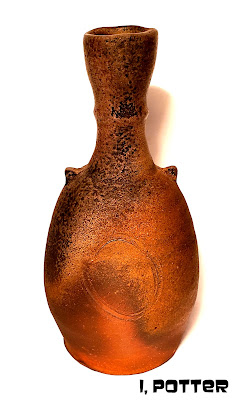I think as I study (well studied) this chawan there is a softer countenance to the bowl, it is less masculine and less aggressive and has a smoother atmosphere which easily settles down in the hands for a rather comforting experience. Like her master, the use of this glaze style has produced a wide array of variations about the surface from rich iron blooms to the plains of dark area being broken up by running ash to tendrils of white feldspar breaking through the surface making for a visual menagerie of all the possibilities of Oni-Iga. Though very much in the style of Tsukigata Nahiko, Ayukai Kogetsu has adapted this surface and techniques to her way of working in clay and as such she has bent the idiom to her vision and sense of a rich and apparently adaptive style.
Wednesday, August 31, 2022
ADAPTIVE
Monday, August 29, 2022
IN THE GROOVE
Friday, August 26, 2022
TEMPORARY TRANSPORT
Wednesday, August 24, 2022
TWO AUSPICIOUS BIRDS
As you can clearly see the perfect choice of glaze was employed where it is rather opaque in the background and semi-transparent on all the detail painting a perfect portrait of the subject matter in textured detail. This tile as I mentioned is double framed and on the reverse of the frame is a hand applied label that reads, " SHINKAI KANZAN MADE THIS, CERAMIC PLAQUE, TWO AUSPICIOUS BIRDS". If the decoration, surface and detail didn't get my (our) attention than the great title certainly did and it is quite perfect for the house where The Birds reside.
Monday, August 22, 2022
SQUARED UP & ASSEMBLED
Friday, August 19, 2022
BUNCHEONG TSUBO
An important dish was presented to her majesty, Queen Elizabeth II that was made by Yoo ByungHo in 1999 which I think attests to the quality of his workmanship and artistry. Coupled with this accolade, this tsubo comes complete with a catalogue from an exhibition held in Japan which prominently illustrates this fine and noble Buncheong tsubo. As I mentioned my working knowledge of the modern South Korean pottery scene isn't 100% but it all boils down to a good pot being just that, a good pot. 좋은 냄비는 좋은 냄비입니다
Wednesday, August 17, 2022
SPARE PARTS
Monday, August 15, 2022
SNOW COVERED DARUMA
Thrown out of a sandy, coarse clay, the form and movement of the piece was just so appealing and to a certain degree amusing looking a bit like a drunken Daruma settled in for a quick and spontaneous nap now covered in a coating of overnight snow. The surface of this casually deformed vase has what appears to be a melting, snow white surface with hints of black breaking through the surface from underneath the glaze with areas of pinks, lavenders and grey all punctuated by fine spots of crystalized titanium (or some other whitening agent) adding to the complex atmosphere of the piece. While admittedly it would not have hurt my (our) feelings to come home from a Japan trip with the large Araki or Hara Kiyoshi pieces but the Udagawa fit neatly in our carry-on and we would have regretted leaving it on the wall between the first and second floors of the exhibit hall where it first caught our attention and at the moment a small amount of snow might be quite welcomed.
Friday, August 12, 2022
DECADES (IN THE MAKING)
This chawan has a story, the story of decades of bowls and other pots made in series both large and small. This story creates a distinct vocabulary that has a commonality while at the same time creating unique works in clay, each with their own nuances and individual tendencies that set each and ever one apart. This chawan is precisely why I like simple and admire the manner in which Kimura Morinobu makes pots, everything he makes is the same but very different at the same time.
Wednesday, August 10, 2022
SIMPLE SANDY SURFACE
As you can imagine the next step beside the bisque is using a transparent or translucent glaze surface over the piece and I doubt it would come as any shock if I said I was thinking about using either Oribe or Kuro-oribe for the job. Though many of my choices may be predictable with the right application of the secondary and tertiary and all that sandy texture, the outcome is usually a bit up in the air allowing for a group of teabowls to emerge, each one with its own distinct voice and appearance. Simple, right, though simple does go a long way.
Monday, August 8, 2022
VISUAL AIDS
Friday, August 5, 2022
ONI-OKE
Wednesday, August 3, 2022
MOONLIGHT
Monday, August 1, 2022
HAGGLING IN NH
As for this Bizen vase it is a simple bud vase with a variety of colors and some goma here and there, some sparkly ash crystals on the neck and mouth and well made enso like marks combed on either side with two very delicate lugs to complete the form. This is an early piece by Masamune Satoru and is a pleasant enough piece that could have made out just a bit better somewhere else in the kiln than where it was placed though I suspect vases like this are studio staples as opposed to his more individualistic and creative endeavors and are relegated to the rear of the kiln but given the cost and memorable story behind it will have a home here for the foreseeable future.
ip%20pg323.jpg)









ip%20pg341.jpg)
b.jpg)

